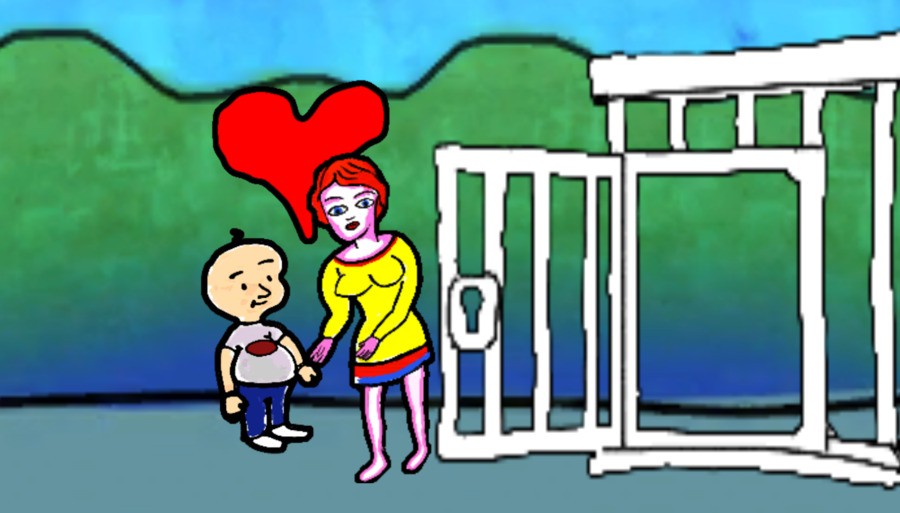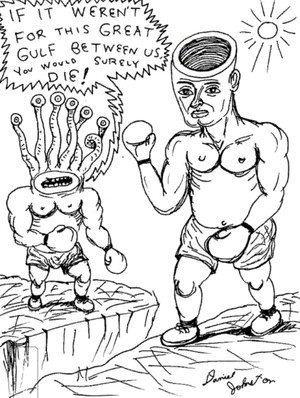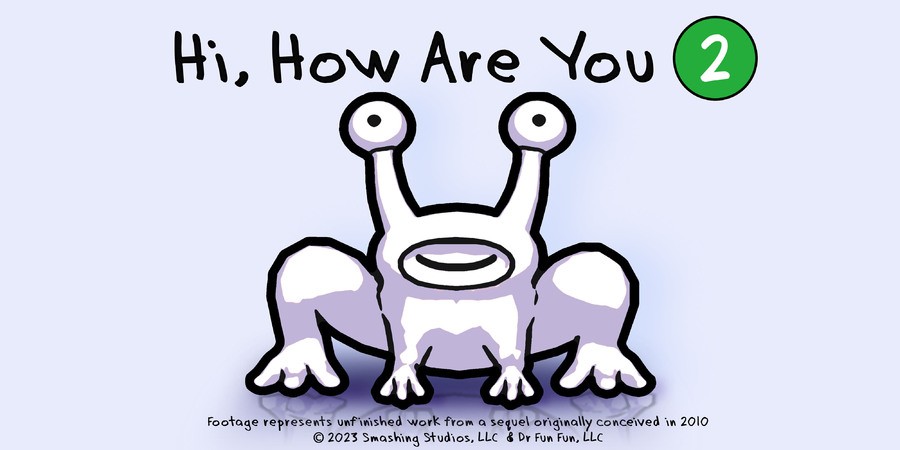
Even if you've never heard of the late singer-songwriter/artist Daniel Johnston, you've probably come across someone he's inspired. Artists including Beck, Wilco, The Flaming Lips, and Karen O have all covered his music in the past. Meanwhile, David Bowie, Kurt Cobain, and Lana Del Rey were/are all huge fans of his work.
His music has often been described as "out of tune" and "amateurish" by online critics. Yet, despite the rough and ready production and the raw, offkey vocals, he was able to build a fairly sizable cult following throughout his life, thanks in part to his earnest, emotional lyrics, fascinating life story, and psychedelic artwork.
In early 2009, two fans of his music — the video game developers Peter Franco and Stephen Broumley — made the incredible decision to reach out to Johnston to see whether they could partner with him to develop an app for iPhone and iPod Touch. The resulting game Hi, How Are You (which was named after his 1983 album of the same name) was released later that same year and was a physics-based 3D platformer that saw players take control of Jeremiah the Innocent (a frog that famously appeared on the cover of Hi, How Are You) as they travel across several stages to defeat the devil and find true love against the backdrop of Johnston's music.
I've always been fascinated in learning more about how this unexpected tie-in came to be, and what input, if any, Johnston had in its creation, but I'd always put off reaching out to its creators for one reason or another. Recently, however, I finally took the plunge and got in touch with Franco and Broumley. They were able to tell me more about what it was like collaborating with Johnston and even revealed some of the preliminary work that they were doing on its abandoned sequel that never saw the light of day. So without further ado, let's dive in and go over the creation of this strange yet endearing tribute to the indie folk legend.
Hi, How Are You
According to both its creators, Hi, How Are You came about thanks to two factors. The first of these was that Broumley and Franco had just recently left their AAA jobs at Midway Studios in Austin and were looking to collaborate again on a smaller project that wouldn't require sleeping under desks or having to manage great big teams of people. The other, meanwhile, was that Franco's wife already had a pre-existing relationship with the Johnston family, helping them with merchandising and licensing Johnston's music.

"We’re both in Austin so I’ve seen him live several times," says Franco. "He was a cult hero out here and my wife, Heather Olson, had been doing business with the Daniel Johnston family for a while. She was helping them with licensed material and merchandising […] and lots of cool stuff. So she did the intro. Steve and I worked together for a while and we had at the time been wanting to make a game together. So we just started brainstorming game ideas."
"I had my own editor and engine," adds Broumley. "But I didn’t know what to use it for. So me and Pete got together and he was like, ‘Hey, maybe we can do some kind of Daniel Johnston game’ and then we went from there. I had learned about him from Pete and his connections, but there was a documentary about him – The Devil and Daniel Johnston. I think that came out before we did the game, right? So I remember watching that and then his music is distinctive and childlike and there was all of this crazy artwork. He’s a very interesting guy."
Franco and Broumley eventually devised an idea for the game that drew inspiration from classic video game titles like Frogger, Marble Madness, and Miner 2049er, with players having to guide Jeremiah (via touch or tilt controls) through each level, stepping on all of the coloured platforms before reaching the exit. All of the characters would be based on pre-existing figures from Daniel Johnston's immense archive of drawings, with the overarching story tapping into the main themes of Johnston's music, including his well-documented obsession with the devil (a symptom of his debilitating mental illness and strong Christian upbringing) and his continuing quest for true love.
As the developers tell me, Daniel Johnston wasn't directly involved in the day-to-day development, with his brother Dick instead acting as a liaison between the two parties. Dick Johnston provided Franco and Broumley with a wealth of reference material to draw from, and would occasionally meet up with the pair whenever Daniel would return to Austin to play a show.
"They were very super supportive," says Franco. "And very interested. Dick especially at the time was taking control of all the branding and stuff. I remember when we showed Daniel the game, he was like, ‘This is great, someone should make a game out of this’. He was much less aware of gaming obviously and what it was. But overall, they were very supportive. Like I said, we would talk regularly. Whenever they were in town touring, I would go meet with them – both Daniel and Dick – so there was a lot of communication."
One of the most interesting challenges of Hi, How Are You for the two developers was attempting to translate Johnston's eccentric artwork from 2D to 3D. To do this, the pair primarily used 3ds Max to create the models, with Franco sampling marker patterns from Johnston's illustrations and using that to texture various objects in-game. Broumley, meanwhile, came up with a cheap and effective way to fake a cartoon black outline without shaders, inverting the mesh of a character, scaling it up, and making it black.

Each of the characters was a rigid body physics object capable of pushing platforms and moving things out of the way. This ended up forming the backbone of some of the puzzles in the game, with players having to maneuver various blocks onto elevators to ascend to different levels of the stage.
As for the music, due to the cost of licensing, the pair could unfortunately only afford to pay the record label for small of a sample of Johnston's music. Songs like "My Favorite Darling Girl", "Love Forever", "Sometime Spent In Heaven", and "True Love Will Find You In The End" all make an appearance, but aren't featured in full to avoid spending the budget entirely on music.
"We had to go through a music publisher to get the license," says Broumley. "And all the rules and regulations were interesting because they wanted a percent per second played, so budgets were really tight and we had to come up with some creative ways where Pete would actually take a 30-second sample and then we’d loop it. So we’d only pay for 30 seconds but then we’d make it last a lot longer than 30 seconds because in the music editor, you can string together samples to make it sound like a real song. So we had to use all kinds of creative things to make sure we didn’t blow the budget on music."
"That was a pretty big thing to have actual music in there," Franco adds. "Even though nowadays most people play mobile games with the audio off, those were the early days, and obviously, it’s a music-oriented game so it was really important to have him in there."
The Big Release
Hi How Are You was released on iPhone and iPod Touch in September 2009, and immediately drew a ton of curiosity and attention from publications like Pocket Gamer, Touch Arcade, The AV Club, The New York Times (who covered the game twice), and The Guardian.
Many of these articles skewed positive, with The New York Times calling it "a kind of psycho-religious version of Frogger", while The AV Club called it "an odd appendage to the songwriter’s output" but "simple and very colorful".
Reflecting on its release, Franco recalls, "It was a mix of a lot of people who were naturally interested from the gaming side of things because we were doing things that no one else was doing at the time on iPhone, but then also Daniel Johnston fans. So there were people at the New York Times and The Guardian who really loved Daniel and wanted to support him and saw this and they were blown away and wanted to talk to us from that perspective. So a lot of the marketing kind of fell into our laps, but we did hire some people to kind of help a little bit."
Broumley chimes in, "Yeah, again it was super low budget. I think the advertisement agency put us in a lot of unsuitable or unrelated blog sites that unfortunately didn't target our demographic. So it didn’t really pay dividends. But we did get in the New York Times twice. And every time it would get mentioned in the New York Times, it would shoot up the charts. It actually got in the top 50 of the iPhone charts. I think the numbers were like 2000 copies a day to reach that number, but then what would happen is a few days later it would just tank back down to selling 10 a day. So from a business standpoint, it wasn’t a financial success. But it was an amazing experience, I think, for both of us."
Following the release of Hi, How Are You, Broumley and Franco collaborated on another game using the same engine — a physics-based arcade action title called Frantic Santa — which was released on the App Store in December 2009. They also began work on developing a couple of other projects that never saw the light of day, including an unreleased app about John Oates' moustache (of Hall & Oates' fame), and ideas and levels for Hi How Are You 2.

"We did start the sequel," claims Franco. "We had dozens of gameplay levels with all new obstacles, enemies, and new abilities. We also had tracks ready to go from as well as tracks ready from his then latest album, Is and Always Was. We featured new characters from the Daniel Johnston universe, including the new main adversary, Vile Corrupt, the boxer with multiple eyes. According to Daniel, Vile Corrupt represented the evil version of Jeremiah the Frog, what he would become if he wasn't careful."
Broumley remembers, "Yeah, we started using vertex shaders for Hi How Are You 2 as well, so instead of just being square blocks of low poly, the next-gen iPhones could actually handle vertex shaders so it would look a lot nicer, have smoother edges, and specular lighting, and all sorts of cool stuff. But life took over, unfortunately."
After Hi, How Are You 2 was put on ice, Broumley and Franco continued to support Hi How Are You for a few years, making sure it stayed available on the App Store and remained compatible with Apple's latest operating systems. But eventually, the pair could no longer justify dedicating any time or resources to keeping it alive.
So the decision was made to finally pull the game from the storefront, which meant the only way to play it was to track down an old iPhone with the app already pre-installed. This remained the case for several years, but then, out of nowhere in 2019, the subscription service Gameclub reached out to the pair about potentially resurrecting the game on its platform.
Incredibly, Gameclub managed to get the game up and running again on the latest OS and even upgraded the graphics quality. It now offers it alongside a ton of other delisted titles for $4.99 a month.
Speaking to Broumley and Franco, they're clearly over the moon that people can still enjoy their work, but also expressed an interest to us in revisiting some of their unfinished work from Hi, How Are You 2 (potentially with the help of crowdfunding). It will be interesting to see if this ever comes to pass, as we'd love to see the pair build on its predecessor with some proper financial backing.
Are you a fan of Daniel Johnston? Have you played Hi, How Are You? Let us know in the comments!
